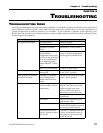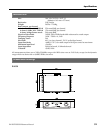
Chapter 3: Operation
RA150/300/500 Reference Manual 25
SYSTEM SETUP AND TESTING
Before applying power for the first time, double
check the wiring to insure that everything is firmly
connected and that the proper signals are being fed
to the proper places. If a low frequency signal in a
multi-amplified system is applied to a high
frequency transducer, the transducer can be
damaged, and a loose connection can cause noise
which can damage any transducer.
Be certain that the amplifier front panel gain
controls are set to minimum when the system
under test is first powered up. After the power is
applied, slowly advance each gain control to
confirm that there are no driver-destroying hums
or buzzes present—if there are, turn the power off
and locate the source of the difficulty.
When first applying program material to the
system, it is also advisable to keep the gain controls
turned down to confirm, once again, that the
wiring is correct. Once the system wiring is
determined to be correct, the gain controls can then
be set to an appropriate level for the system gain
structure.
SETTING THE GAIN PROPERLY
Setting the system gain is fairly straightforward,
but if it is not properly adjusted, the system’s
distortion and noise characteristics may be less
than optimum.
The most common cause of noisy operation,
especially in studio use, is that the amplifier's
gain controls are left all the way up, while the
mixer's output is turned down. This can lead
to blown speakers if the mixer is accidentally
turned up, but more importantly, it amplifies
the noise floor of the mixer output stage or
wiring unnecessarily. Keeping the source
level as high as possible and lowering the
amplifier input gain will keep the noise level
at a minimum.
The input sensitivity of the RA150/300/500
amplifiers at the 1/4" input or XLR input is
1.23 volts (+4 dBu) for rated output with the
amplifier gain controls at maximum. If you're
plugged into the phono jacks, the sensitivity is
–10 dBV (.316 volts). If the signal at the amplifier
input is higher than this, the input gain controls
of the RA150/300/500 must be turned down to
avoid amplifier clipping. Most mixers output +4
dBu at nominal level/0 VU; that means if you go
"into the yellow" on the meter of most mixers, the
amp will be clipping its outputs or distorting the
speakers unless you turn down the input gain
controls.
It is generally best to try to keep the gain of the
source device set for best signal-to-noise ratio
consistent with distortion, and to then set the
amplifier inputs for the desired SPL level.
A good way to set levels is to use a test tone or
pink noise with a sound level meter. Set the
mixer's controls at nominal levels, increase
the test tone until the mixer is exercising its
dynamic range without clipping itself. The
mixer's meter should read from +10 to +15.
Then slowly raise the RA150/300/500's input
level controls until the desired peak sound
pressure level is achieved.


















